The global agriculture enzyme market is expected to expand from USD 605.88 million in 2025 to USD 1,169.76 million by 2035, progressing at a CAGR of 6.8% during the forecast period. This growth is driven by the increasing adoption of biological alternatives in agriculture and the rising demand for sustainable farming practices.
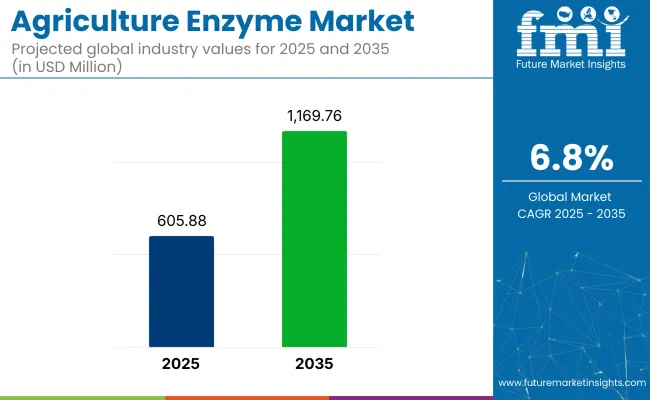
| Metric | Value |
|---|---|
| Industry Size (2025E) | USD 605.88 million |
| Industry Value (2035F) | USD 1,169.76 million |
| CAGR (2025 to 2035) | 6.8% |
Agricultural enzymes, which play a crucial role in enhancing soil health, promoting nutrient cycling, and improving crop yields, are gaining traction among farmers looking for eco-friendly alternatives to conventional chemical inputs. As agricultural systems move towards more biological solutions, the industry for agricultural enzymes continues to expand.
The agriculture enzyme industry represents a small but significant portion of its parent industries. In the broader agricultural inputs industry, it holds around 2-3% of the share, as agricultural enzymes are just one category among fertilizers, pesticides, and other chemical inputs. Within the biological crop protection industry, agricultural enzymes make up approximately 5-7%, as they are part of the growing trend toward biologically-based alternatives to chemical pesticides.
The soil health & fertility industry sees agricultural enzymes at 6-8%, as they are used to enhance soil microbial activity and nutrient cycling. In the organic farming inputs industry, enzymes account for around 10-12%, driven by organic farming’s reliance on biological products. Finally, within the biotechnology & industrial enzymes industry, agricultural enzymes make up about 2-3%, as they are a specialized subset.
In September 2024, a strategic partnership between AgIdea and Elemental Enzymes was announced to advance the screening of cutting-edge agricultural enzyme technologies in the United States, focusing on row crops.
This three-year collaboration builds upon nearly a decade of successful innovation and is poised to accelerate the development of biologically-based farming solutions. Brian Thompson, CEO of Elemental Enzymes, expressed his enthusiasm: “We’re excited to leverage AgIdea’s expertise during this crucial stage of our business development. This agreement highlights the value of such collaborations in bringing our innovative solutions to market.”
Key segments driving this growth include phosphatases, cereals & grains, and fertility products. This expansion is driven by rising demand in agriculture, food production, and health sectors, fueled by global food security concerns and growing awareness of enzyme-based solutions for improving crop yields and soil health.
The enzyme type segment is projected to be led by phosphatases, capturing 25% of the share in 2025. These enzymes play a key role in catalyzing important biochemical reactions, particularly in agriculture and the food industries. Their increasing application in the agricultural sector, particularly in soil fertility, and in food and beverages to improve processing and quality, will contribute to their dominance.
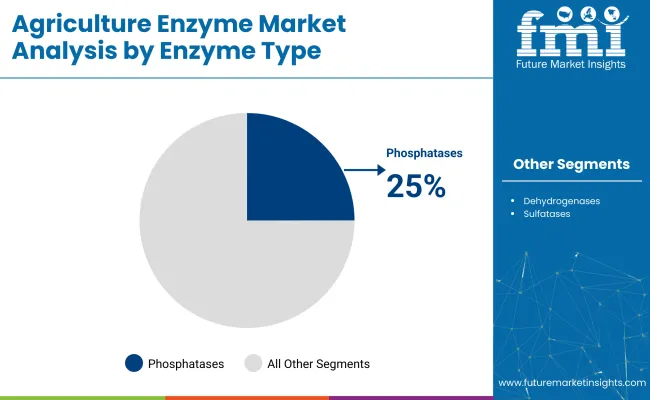
The crop type segment is expected to see cereals & grains dominate, holding a 35% share in 2025. This growth is attributed to the widespread cultivation of cereals like wheat, corn, and rice, which are staple crops used in global food systems. The demand for high-yielding, resilient cereal crops, driven by climate change and population growth, supports this trend.
Fertility products are projected to lead the product type segment with a 40% share by 2025. Fertility products, including supplements, diagnostics, and treatments, are being increasingly used for reproductive health concerns. The growth is driven by a rising awareness of fertility issues and a growing demand for solutions to manage both male and female reproductive health.
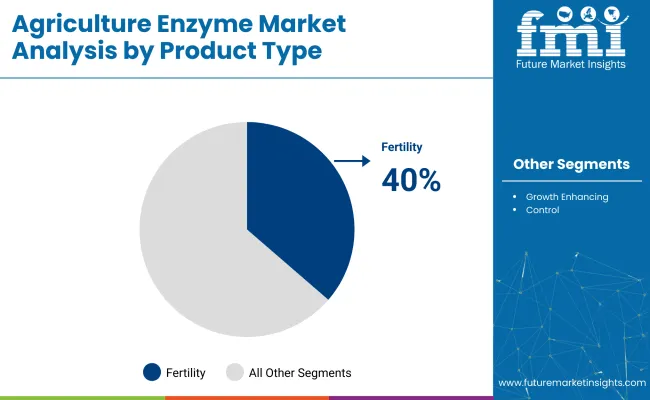
Manufacturers in the market are focusing on product innovation, cost-effectiveness, and enhanced crop yield optimization. Strong demand from the agricultural and bio-based industries is driving innovation.
Rising Demand for Bio-Based Solutions in Agriculture
The increasing demand for bio-based solutions in agriculture is being driven by the need for sustainable farming practices. Enzymes are being adopted to enhance soil health, optimize crop yields, and improve nutrient absorption, as agriculture shifts toward more eco-friendly, organic methods.
High Production Costs and Limited Awareness
Despite the benefits of agricultural enzymes, high production costs and limited awareness among small-scale farmers present significant challenges. The price of advanced enzyme formulations can be prohibitive for farmers with limited budgets, and the lack of knowledge about their effectiveness slows adoption.
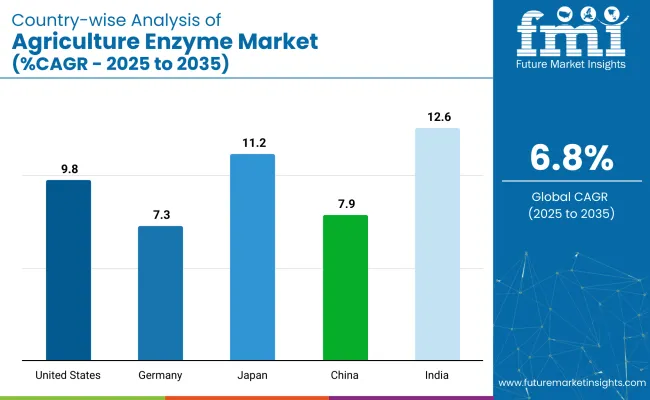
| Country | CAGR (2025 to 2035) |
|---|---|
| United States | 9.8% |
| Germany | 7.3% |
| Japan | 11.2% |
| China | 7.9% |
| India | 12.6% |
The agriculture enzyme industryshows varied growth across OECD and BRICS countries. Among the OECD countries, the United States and Germany exhibit steady growth, with respective CAGRs of 9.8% and 7.3%, driven by increasing adoption of sustainable farming practices and a growing preference for bio-based agricultural solutions.
Germany leads within the OECD, benefiting from strong consumer demand for organic farming products and eco-friendly agricultural solutions. In contrast, Japan experiences higher growth at 11.2%, fueled by technological advancements in precision agriculture and innovation in bio-based products.
In the BRICS group, India stands out with a strong 12.6% CAGR, driven by rapid agricultural growth, government initiatives for sustainable farming, and the increasing demand for eco-friendly solutions. China follows with a 7.9% CAGR, propelled by rising awareness of health-conscious farming and the adoption of green practices. India’s remarkable growth highlights the shift in global demand toward emerging industries, where sustainable farming practices are gaining traction.
The demand for the agriculture enzymesin India is projected to grow at a CAGR of 12.6% from 2025 to 2035. The growth is driven by the increasing demand for sustainable farming practices and the rising adoption of bio-based solutions in agriculture. The focus on improving crop yields and reducing chemical usage is boosting the industry for natural enzymes.
The country’s rapidly expanding agricultural sector and government initiatives supporting organic farming are further contributing to industry growth. The agricultural enzyme industry is also benefiting from the growing awareness of environmental sustainability among farmers and producers.
The agriculture enzyme industryin the United States is expected to grow at a CAGR of 9.8% from 2025 to 2035. This growth is supported by the growing emphasis on sustainable farming practices and the need for soil health improvement. Agricultural enzymes are becoming increasingly important for enhancing crop productivity and reducing dependency on synthetic chemicals. The USA sector is driven by technological advancements in enzyme formulations, which are improving crop yields, and by the increasing use of enzymes in fertilizers and soil treatments.
Sales of agriculture enzyme in Germanyare expected to grow at a CAGR of 7.3% from 2024 to 2034. The growth is supported by the country’s strong focus on sustainable agriculture and organic farming practices. With a high demand for bio-based products, Germany is leading the adoption of enzymes that help improve crop productivity while reducing environmental impacts. Government initiatives promoting organic farming and environmental sustainability are further contributing to industry growth. The presence of well-established agricultural producers and research institutions is also accelerating the development and use of agricultural enzymes.
The agriculture enzyme industry in China is expected to grow at a CAGR of 7.9% from 2025to 2035. The growth is driven by the country’s rapid agricultural expansion and the increasing need for sustainable farming solutions. The industry is benefiting from advancements in enzyme technology and an increased focus on reducing chemical fertilizers and pesticides. The country’s large agricultural base, combined with government policies promoting green farming, is driving the adoption of agricultural enzymes.
Demand for agriculture enzyme in Japan is forecasted at a CAGR of 11.2% from 2025 to 2035. The country’s emphasis on high-tech agricultural practices and sustainability is driving the demand for enzyme-based solutions. Japan is focusing on reducing chemical inputs in agriculture and enhancing soil health, which is supporting the growth of the industry. Increasing consumer demand for organic food products is further accelerating the adoption of agricultural enzymes.
Leading Company - BASF SE Industry Share - 15%
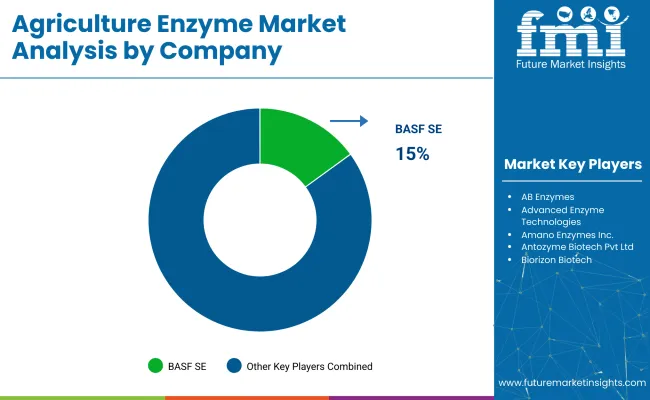
The agricultural enzyme industry is competitive, with dominant players, key contributors, and emerging firms. Leading companies such as BASF SE, Novozymes A/S, Syngenta AG, and Elemental Enzymes hold significant industry positions, offering a wide range of enzymes like phosphatases, proteases, and ureases for applications in crop protection and soil fertility.
Their leadership is supported by continuous product innovation, sustainability practices, and expanding distribution networks. Emerging players such as Bioworks Inc., Kemin Industries, and Advanced Enzyme Technologies add dynamism to the industry by offering specialized and organic enzyme solutions that cater to the growing demand for natural and eco-friendly agricultural products.
Recent Industry News
| Report Attributes | Details |
|---|---|
| Industry Size (2025) | USD 605.88 million |
| Industry Size (2035) | USD 1,169.76 million |
| CAGR (2025 to 2035) | 6.8% |
| Base Year for Estimation | 2024 |
| Historical Period | 2020 to 2024 |
| Projections Period | 2025 to 2035 |
| Quantitative Units | USD million for value and tons for volume |
| Enzyme Types Analyzed (Segment 1) | Phosphatases, Dehydrogenases, Sulfatases |
| Crop Types Analyzed (Segment 2) | Cereals & Grains, Oilseeds & Pulses, Fruits & Vegetables, Turf & Ornamentals, Others |
| Product Types Analyzed (Segment 3) | Fertility Products, Growth Enhancing Products, Control Products |
| End-Uses Analyzed (Segment 4) | Consumer Durables (Mobile Phones, Laptops, etc.), Food & Beverages (Egg Packaging, Wine Packaging, etc.), Cosmetics, Food Services, Healthcare, Automotive, Logistics, Others |
| Regions Covered | North America, Latin America, Europe, East Asia, South Asia, Oceania, Middle East & Africa |
| Countries Covered | United States, Canada, Germany, United Kingdom, France, Italy, Spain, China, India, Japan, South Korea, Australia, Brazil, Mexico, Argentina, Saudi Arabia, UAE, South Africa |
| Key Players | AB Enzymes, Advanced Enzyme Technologies, Amano Enzymes Inc., Antozyme Biotech Pvt Ltd., Biolaxi Enzymes Pvt Ltd., Biorizon Biotech, Creative Enzymes, Elemental Enzymes, Inc., Field International UK Limited, Grotech Production Ltd, Infinita Biotech Private Limited, Kemin Industries, Inc. |
| Additional Attributes | Dollar sales, share by enzyme type and crop type, demand growth in organic and sustainable farming, regional application trends, technological advancements in enzyme-based agricultural solutions |
As per enzyme type, the industry has been categorized into Phosphatases, Dehydrogenases, and Sulfatases.
Different crop type include Cereals & Grains, Oilseeds & Pulses, Fruits & Vegetables, Turf & Ornamentals and Others
Different Product types include Fertility Products, Growth Enhancing Products, Control Products
Industry analysis has been carried out in key countries of North America, Latin America, Europe, East Asia, South Asia, Oceania, and the Middle East & Africa.
The industry is expected to reach USD 1,169.76 million by 2035.
The industry is projected to grow at a CAGR of 6.8% from 2025 to 2035.
Fertility products are expected to dominate with a 40% share in 2025.
South Asia, particularly India, is expected to lead with a CAGR of 12.6%.
The industry value is projected to be USD 605.88 million in 2025.






Full Research Suite comprises of:
Market outlook & trends analysis
Interviews & case studies
Strategic recommendations
Vendor profiles & capabilities analysis
5-year forecasts
8 regions and 60+ country-level data splits
Market segment data splits
12 months of continuous data updates
DELIVERED AS:
PDF EXCEL ONLINE
Agriculture Gateway Market Size and Share Forecast Outlook 2025 to 2035
Agriculture Solar Water Pumps Market Size and Share Forecast Outlook 2025 to 2035
Agriculture Fertilizer Spreader Market Size and Share Forecast Outlook 2025 to 2035
Agriculture Packaging Market Size and Share Forecast Outlook 2025 to 2035
Agriculture Analytics Market Size and Share Forecast Outlook 2025 to 2035
Agriculture IoT Market Size and Share Forecast Outlook 2025 to 2035
Market Share Breakdown of Agriculture Packaging Solutions
Agriculture Bags Market
Agriculture Testing Services Market Growth – Trends & Forecast 2018-2028
Non-Agriculture Smart Irrigation Controllers Market Size and Share Forecast Outlook 2025 to 2035
Smart Agriculture Market Size and Share Forecast Outlook 2025 to 2035
Ai In Agriculture Market Size and Share Forecast Outlook 2025 to 2035
Smart Agriculture Solution Market Analysis by Component Type, Application, and Region Through 2035
Precision Agriculture Market
Regenerative Agriculture Market Size and Share Forecast Outlook 2025 to 2035
Blockchain in Agriculture and Food Supply Chain Market Size and Share Forecast Outlook 2025 to 2035
Blockchain in Agriculture Market Analysis – Size, Share & Forecast 2024-2034
Controlled Environment Agriculture (CEA) Market Size and Share Forecast Outlook 2025 to 2035
Enzymes for Laundry Detergent Market Size and Share Forecast Outlook 2025 to 2035
Enzymes Market Size and Share Forecast Outlook 2025 to 2035

Thank you!
You will receive an email from our Business Development Manager. Please be sure to check your SPAM/JUNK folder too.
Chat With
MaRIA